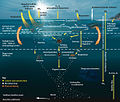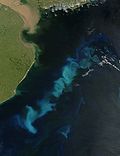Carbon sequestration: Difference between revisions
CSV import Tags: mobile edit mobile web edit |
CSV import |
||
| Line 32: | Line 32: | ||
{{climate change}} | {{climate change}} | ||
{{environment-stub}} | {{environment-stub}} | ||
<gallery> | |||
File:Carbon_sequestration-2009-10-07.svg|Carbon sequestration | |||
File:Proportion_of_carbon_stock_in_forest_carbon_pools,_2020.svg|Proportion of carbon stock in forest carbon pools, 2020 | |||
File:Wetland_in_Skippack_Township,_MontCo_PA.jpg|Wetland in Skippack Township, MontCo PA | |||
File:Journal.pone.0043542.g001.TIF|Carbon sequestration | |||
File:Panicum_virgaturn_heavy_metal_switch_grass_MN_2007.JPG|Panicum virgatum heavy metal switch grass MN 2007 | |||
File:Charcoal2.jpg|Charcoal | |||
File:Oceanic_Food_Web.jpg|Oceanic Food Web | |||
File:Kelp_Forest_(12801115735).jpg|Kelp Forest | |||
File:Seagrass_at_Rapid_Bay_Jetty_P1262907.JPG|Seagrass at Rapid Bay Jetty | |||
File:WomenWorking_SeaweedZanzibar_2.jpg|Women working with seaweed in Zanzibar | |||
File:Phytoplankton_SoAtlantic_20060215.jpg|Phytoplankton in the South Atlantic | |||
</gallery> | |||
Latest revision as of 11:59, 18 February 2025
Carbon sequestration is the process by which carbon dioxide (CO2) is captured from the atmosphere and stored to mitigate global warming and climate change. This process can occur naturally, such as through photosynthesis in plants, or it can be artificially induced through various technologies.
Natural Carbon Sequestration[edit]
Natural carbon sequestration occurs primarily through the process of photosynthesis in plants and phytoplankton. These organisms absorb CO2 from the atmosphere and convert it into organic matter, such as glucose, through the process of photosynthesis. When these organisms die and decompose, the carbon they have absorbed is transferred to the soil or the ocean floor, where it can remain sequestered for hundreds to thousands of years.
Artificial Carbon Sequestration[edit]
Artificial carbon sequestration involves the use of technology to capture and store CO2. This can be done in several ways, including carbon capture and storage (CCS), carbon capture and utilization (CCU), and bio-energy with carbon capture and storage (BECCS).
CCS involves capturing CO2 emissions from large point sources, such as power plants, and transporting it to a storage site where it is injected into the ground. CCU, on the other hand, involves capturing CO2 and converting it into useful products, such as fuels, chemicals, and building materials. BECCS involves the combination of bioenergy production with CCS, resulting in net negative emissions.
Challenges and Controversies[edit]
While carbon sequestration has the potential to significantly reduce greenhouse gas emissions, it also presents several challenges and controversies. These include the high cost of CCS technologies, the risk of CO2 leakage from storage sites, and the potential for increased demand for biomass in BECCS to lead to land use changes and biodiversity loss.
See Also[edit]
- Climate change mitigation
- Greenhouse gas
- Carbon capture and storage
- Carbon capture and utilization
- Bio-energy with carbon capture and storage
References[edit]
<references />

This article is a environment-related stub. You can help WikiMD by expanding it!
-
Carbon sequestration
-
Proportion of carbon stock in forest carbon pools, 2020
-
Wetland in Skippack Township, MontCo PA
-
Carbon sequestration
-
Panicum virgatum heavy metal switch grass MN 2007
-
Charcoal
-
Oceanic Food Web
-
Kelp Forest
-
Seagrass at Rapid Bay Jetty
-
Women working with seaweed in Zanzibar
-
Phytoplankton in the South Atlantic









